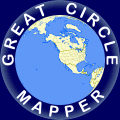Featured Map for 15 May 2017:
Rare Birds: Boeing 737-600
The Boeing 737 was launched when Lufthansa ordered 21 on 19 February 1965. This initial 737-100 series was 94 ft (28.63 m) long. United wanted more seats, though, and on 5 April 1965 ordered 40 of what became the 737-200, which with a stretch of 76 in (1.93 m) had room for two more rows of seats. The 737 first flew on 9 April 1967. Lufthansa's first 737-100 delivery took place on 28 December 1967 and the next day United received their first 737-200.
Almost 17 years after the original 737 first flew, the 737 Classic took to the air on 24 February 1984. In addition to new engines and other upgrades, this 737-300 was stretched to 109 ft 2 in (33.40 m) from nose to the trailing tips of the horizontal stabilizers. After yet another stretch to create the 737-400, Boeing matched a fuselage with the approximate length of the 737-200 with the 737-300's improvements to create the 737-500.
Another 13 years saw the third generation of the 737 (the Next-Generation 737 or NG for short) take flight, with a 737-700 that had approximately the same length as the 737-300. Even further stretches followed in the form of the 737-800 and 737-900, but between them Boeing returned to the fuselage size of the 737-200 to create the 737-600 for launch-customer SAS.
The 737-600 generated the second-fewest orders of any major 737 model with just 69 built. (Only 30 of the 737-100 were produced. Like the Airbus A318, the subject of an eariler Featured Map, short versions of airliners tend not to do well in the market.) The 737-600 is the only NG model that is no longer offered and which will not be continued in the new 737 MAX family. 51 of these rare birds are still in service with five airlines in Europe, Africa, and North America.
Today's Featured Map shows where one can find a 737-600 in service, incidentally illustrating some artistry that goes into making complex maps meaningful. With so many paths, labels would clutter the map without adding much value, so each network is depicted in a color associated with that airline. Even that required some thought since Air Algérie and Tunisair both use a similar red; to differentiate them the Air Algérie network uses the green from the Algérian flag.
- SAS (blue) flies 20 737-600s, primarily from their hubs in Stockholm and Oslo.
- Tunisair (red) flies seven 737-600s, primarily from their hub in Tunis.
- Air Algérie (green) flies five 737-600s, primarily from their hub in Algiers.
- WestJet (teal) flies 13 737-600s, primarily from their hubs in Toronto and Calgary.
- "Janet Airlines" (black) is a fascinating case, flying six 737-600s formerly operated by Chinese airlines, primarily from their hub in Las Vegas. Owned by the U.S. Air Force, these aircraft are used for scheduled flights to Tonopah and Palmdale, though evidence suggests that some of the "Tonopah" flights are actually to the highly classified airfield at Groom Lake, more commonly known as Area 51. Several other locations where these aircraft appear are also marked.
References and additional information:
- Boeing
- Boeing 737-600 Production List – Planespotters.net
- Boeing 737 Detailed Technical Data
- Airlines:
- "Janet Airlines:"
- Featured Map: A318: Across the Pond, or Parts (7 October 2010)
|
Information on this site may not be accurate or current and is not valid for flight planning or navigation. No warranty of fitness for any purpose is made or implied. Flight planning and navigation should only be done using official charts.
Copyright © 2010-2024
Karl L. Swartz.
All rights reserved.
|
